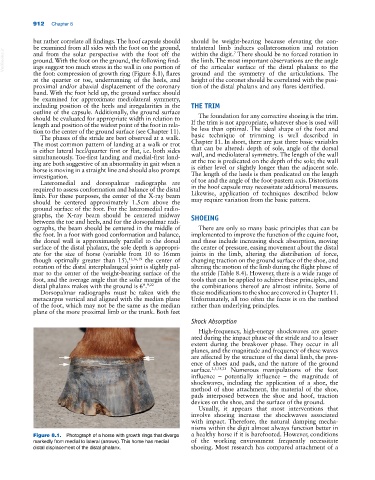Page 946 - Adams and Stashak's Lameness in Horses, 7th Edition
P. 946
912 Chapter 8
but rather correlate all findings. The hoof capsule should should be weight‐bearing because elevating the con-
be examined from all sides with the foot on the ground, tralateral limb induces collateromotion and rotation
VetBooks.ir ground. With the foot on the ground, the following find- the limb. The most important observations are the angle
within the digit. There should be no forced rotation in
and from the solar perspective with the foot off the
7
of the articular surface of the distal phalanx to the
ings suggest too much stress in the wall in one portion of
the foot: compression of growth ring (Figure 8.1), flares ground and the symmetry of the articulations. The
at the quarter or toe, underrunning of the heels, and height of the coronet should be correlated with the posi-
proximal and/or abaxial displacement of the coronary tion of the distal phalanx and any flares identified.
band. With the foot held up, the ground surface should
be examined for approximate mediolateral symmetry,
including position of the heels and irregularities in the THE TRIM
outline of the capsule. Additionally, the ground surface
should be evaluated for appropriate width in relation to The foundation for any corrective shoeing is the trim.
length and position of the widest point of the foot in rela- If the trim is not appropriate, whatever shoe is used will
tion to the center of the ground surface (see Chapter 11). be less than optimal. The ideal shape of the foot and
The phases of the stride are best observed at a walk. basic technique of trimming is well described in
The most common pattern of landing at a walk or trot Chapter 11. In short, there are just three basic variables
is either lateral heel/quarter first or flat, i.e. both sides that can be altered: depth of sole, angle of the dorsal
simultaneously. Toe‐first landing and medial‐first land- wall, and mediolateral symmetry. The length of the wall
ing are both suggestive of an abnormality in gait when a at the toe is predicated on the depth of the sole; the wall
horse is moving in a straight line and should also prompt is either level or slightly longer than the adjacent sole.
investigation. The length of the heels is then predicated on the length
Lateromedial and dorsopalmar radiographs are of toe and the angle of the foot‐pastern axis. Distortions
required to assess conformation and balance of the distal in the hoof capsule may necessitate additional measures.
limb. For these purposes, the center of the X‐ray beam Likewise, application of techniques described below
should be centered approximately 1.5 cm above the may require variation from the basic pattern.
ground surface of the foot. For the lateromedial radio-
graphs, the X‐ray beam should be centered midway SHOEING
between the toe and heels, and for the dorsopalmar radi-
ographs, the beam should be centered in the middle of There are only so many basic principles that can be
the foot. In a foot with good conformation and balance, implemented to improve the function of the equine foot,
the dorsal wall is approximately parallel to the dorsal and these include increasing shock absorption, moving
surface of the distal phalanx, the sole depth is appropri- the center of pressure, easing movement about the distal
ate for the size of horse (variable from 10 to 16 mm joints in the limb, altering the distribution of force,
though optimally greater than 15), 11,16,19 the center of changing traction on the ground surface of the shoe, and
rotation of the distal interphalangeal joint is slightly pal- altering the motion of the limb during the flight phase of
mar to the center of the weight‐bearing surface of the the stride (Table 8.4). However, there is a wide range of
foot, and the average angle that the solar margin of the tools that can be applied to achieve these principles, and
distal phalanx makes with the ground is 6°. 9,22 the combinations thereof are almost infinite. Some of
Dorsopalmar radiographs must be taken with the these modifications to the shoe are covered in Chapter 11.
metacarpus vertical and aligned with the median plane Unfortunately, all too often the focus is on the method
of the foot, which may not be the same as the median rather than underlying principles.
plane of the more proximal limb or the trunk. Both feet
Shock Absorption
High‐frequency, high‐energy shockwaves are gener-
ated during the impact phase of the stride and to a lesser
extent during the breakover phase. They occur in all
planes, and the magnitude and frequency of these waves
are affected by the structure of the distal limb, the pres-
ence of shoes and pads, and the nature of the ground
surface. 2,3,18,21 Numerous manipulations of the foot
influence – potentially influence – the magnitude of
shockwaves, including the application of a shoe, the
method of shoe attachment, the material of the shoe,
pads interposed between the shoe and hoof, traction
devices on the shoe, and the surface of the ground.
Usually, it appears that most interventions that
involve shoeing increase the shockwaves associated
with impact. Therefore, the natural damping mecha-
nisms within the digit almost always function better in
Figure 8.1. Photograph of a horse with growth rings that diverge a healthy horse if it is barefooted. However, conditions
markedly from medial to lateral (arrows). This horse has medial of the working environment frequently necessitate
distal displacement of the distal phalanx. shoeing. Most research has compared attachment of a

